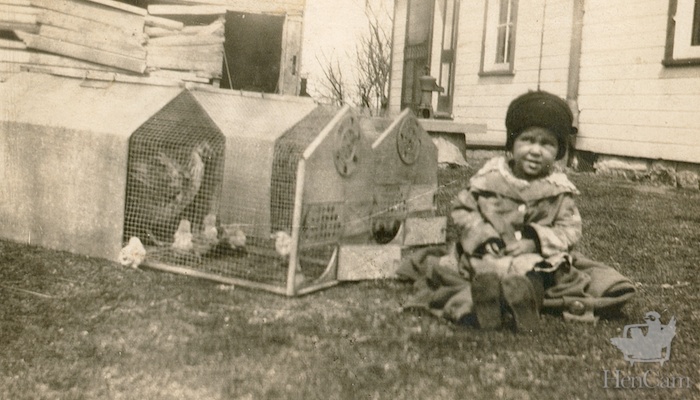It’s chick season and a lot of you have fluffy ones on order. Some of you are being a bit more spontaneous and are scooping up chicks that you see peeping away at the feed store (hard to resist!) If you already have a flock, you can’t just add the chicks to the group. They need to be kept in a brooder, where the temperature starts out at over 90 degrees, there are no drafts, and appropriate food and water is right at hand. But, even more importantly than that, the chicks need to be kept safe from the older girls. The hens, unlike you, don’t say, Babies, how cute! Rather, they’ll yell, Intruders! Get them! So, you’ll need a brooder and separate housing for your new birds until they are fully feathered out and can be integrated into the flock (for more about that see this post, and then this one.)
Perhaps you have a broody hen, and you think, Finally! I can put her to use! The idea is that you tuck the day-old chicks under her at night, she wakes up, sees that she’s a mother, and sallies forth to care of her babies. No heat lamp needed. This is actually a great idea if the hen is seriously broody and if you have separate housing for her. Even the most protective mama hen can’t keep her chicks safe from an angry flock. What you’ll need is a broody coop. My vintage chicken keeping manuals are full of designs for them.
Often, this is how farmers raised all of their chicks. The hens were kept apart and the chicks (under the guidance of a young farmer, as seen below) could forage and mingle.
Sadly, I see many prefab coops on the market that are based on this design and being sold as housing for adult, urban flocks. These are not appropriate for anything other than sheltering the hen and chicks for the first month. For more about coop design, see this FAQ, and go to my Pinterest page where you’ll find some examples of good small coops.
I’ve always wanted to tuck chicks under a broody hen, but my broodies always, right before the chicks arrive, snap out of it and foil my plans. Have you had any success? Tell me!


I did that a few years ago. Not only was it the easiest chick raising year I’ve ever had, the chicks (who are now full-grown hens, of course) integrated into the flock seamlessly. I still have trouble every now and then with the brooder-raised hens getting picked on, but the mama-hen-raised chicks just stepped right into the flock hierarchy with no problems.
Great input!
We have a buff orp who was born broodie….she is a good mother, too..right now she is setting and working on hatching out some chicks whose eggs came from a fertile flock….they are due any day…I have given her some ordered chicks and she has been good at raising them…..then there are my Bearded Belgian D’anvers who love to set but are not good mothers…we tried last year and the chicks just die..but I did do an incubater batch in my utility room…. that hatch gave me a few hens to choose from..one of the hens I hatched out became broodie…so I let her have 3 eggs this year and she was successful with 2 of the eggs but I have to take them away and hand raise them for awhile..they look like bumble bees…small and dainty…fun to watch…when they are a few weeks old I will try to reunite them with their mother….we will see….it’s so fun to have chickens…..thanks for your website I look every day to see what you are doing….take care…:)
I’d like to see those tiny chicks :)
I have had much success giving chicks to broody hens and is my preferred method of raising chicks, easey peasey.
The chicks generally have to be 3 or less days old. I find any older than that and they just don’t seem to imprint on the hen very well.
The slip them under the hen under the cover of darkness works very well. Hen and chicks are very quiet and no one is the smarter come morning. I do have one hen, Ebay, ( who is currently broody)will take them during the day but most hens peck the chicks and violently I might add. The night time method give the hens and chicks a chance to imprint of each other through their chirps, gurgles and peeps.
I also have learned through experience is best to only give chicks to hens who have been broody for a minimum of two weeks. Any sooner than that and I have found the hen is not as receptive and/or the instinct to mother (feed/water/protect) hasn’t fully engaged.
Love those broody coops in the photo. I wonder what the pinwheel type thing is a the top is for? I wouldn’t think ventilation since it’s open air.
Thanks for sharing your expertise. I wondered about that circle thingy, too. Perhaps something to do with the circular opening below?
Yea, I had a broody BO raise babies for me last year. I read that you need to let her brood for at least 14 days and preferably closer to 21 so I waited for 21 days exactly. Brought home baby chicks and set the box of peeping chicks next to her for about an hour and watched her whole demeanor change. She became VERY interested in the box. So after an hour, I slowly tucked a baby chick under her and slipped out one of the fake eggs and watched. She took to the chick immediately, chuck chuck chuck. So I slowly slipped the other two under her and again watched her but she knew exactly what to do. Showed no sign of aggression and proudly raised up those babies for me. Was the sweetest thing in the whole wide world.
Was planning on doing it again this year but sadly, we lost her. So I now have 4 baby BO’s in the garage in a brooder and I’m their surrogate mama this time around.
Maybe one of those will turn into the perfect broody for you.
Our broody Australorp raised 6 chicks (day-old) we picked up from a local hatchery. She was our only hen at the time, so we didn’t have to worry about other hens (we wouldn’t have tried it otherwise–no room for a broody coop). We had her nesting in a cardboard box that I’d rigged up so we could sneak chicks under her from behind without her seeing us. Like Amy, we waited until day 21 to get the chicks, and we put the box of chicks in the coop for a little while before introducing them, so she could hear the peeping and go into full-on mama mode. (I couldn’t do the nighttime-introduction method–I would have been up all night worrying!) She did beautifully, and it’s true that there is nothing sweeter than a mama hen with her chicks. The whole experience was really fun and fascinating. One of the chicks (a BO) went broody the following spring and we gave her to our neighbors to raise their new day-old chicks, which also worked perfectly.
I highly recommend this method to anyone who can manage it! It was SO much easier than having a brooder in the basement–no mess or stress, just cuteness. We even went away on vacation and they were totally fine. There were no issues, illnesses, or injuries, and we have the same proportion of friendly, sociable hens as we did with our flock that was raised in the basement. I hope we’re lucky enough to get to do it all again someday!
I keep hoping that one of my 3 girls will go broody so that I can try this. It is so strange that last year my two Barred Rocks were laying 27-29 eggs/month and now, after turning 2 years old, one is laying about 10/month and the other lays only soft eggs. Being broody would make them useful.
I should clarify…they were laying 27-29 eggs/month EACH.
We have bad broody hens that do not get to the point of hatching chicks. We recently purchased a broody coop for them as we had one broody hen who had been broody for about a week in a half. Once the coop arrived and my husband and son assembled it, we moved her and her eggs to it. She must have not liked being disturbed because she did not constantly sit on the nest, and all chicks died in the eggs. We had no babies that way.The first time she went broody (before we got the coop) a possum ate every egg. I am still waiting on a broody hen to raise babies.
I should clarify..I did not mean ‘bad broody hens’….. I meant, ‘We have had broody hens.’ I really should read my post before clicking Submit Comment. Our hens have not been bad. They are sweet and good.
I do the same thing – and that dratted spell check changes words. It never lets me type “vent gleet.” (I had to retype this 3 times before it stopped inserting “fleet”!
I have a wonderful sillkie that LOVES to be a mama to baby chicks when ever she can. She has had fertile eggs placed under her and hatched out six babies, that was last year. This year she raised 4 day old Australorp chicks for a friend of mine and now has 6 bantum babies under her. I just put them under her anytime of day and she spreads her wings and coos at them and proudly says “I have babies!” I keep her in my house all by herself and she is in heaven! Then when they are fully feathered I intragrate them into my flock.
Some people keep Silkies just for their broody/mama abilities. Look like you have a great one.
Wonderful coops, and not so different from many we can purchase today – thanks for uploading, Terry. I echo Lori’s comments about her silkie: I have one very similar, always broody after laying a dozen eggs and very difficult to break. This time, I relented and bought some day-old chocolate cuckoo marans females (sex-linked breed); she took the first during the day, so I decided to add the other three about an hour later. Wonderful mother, true to her vocation and a fantastic source of heat and security.